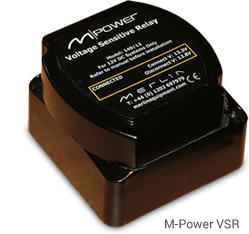Intelligent Split Charging
Power Where You Need It Most
Split charging allows one charging source (generator, alternator, fuel cell, solar panel, etc.) to charge multiple battery banks. A split charging system that charges multiple batteries must also allow each battery bank to discharge independently. Consider a system consisting of an engine, alternator, starter battery, and auxiliary bank. The alternator must charge both the starter battery and auxiliary bank. However, when the auxiliary bank is discharged, the starter battery should typically be isolated to ensure that the engine can be started even if the auxiliaries go dead.

There Are Several Other Factors To Consider For Your Split Charging System:
Efficiency:
Legacy split charging battery technologies such as Battery Isolators waste a lot of power. Battery Isolators using diodes contain large heat sinks because much of the power intended for your batteries is shed as heat.
Battery Overcharging and Undercharging:
Diode-based Battery Isolators also introduce a problematic voltage drop. Consequently, batteries are not charged at the correct voltage (undercharged). Furthermore, overcharging occurs when a starter battery is in a system with a relatively large auxiliary bank. (This is a problem even with FET isolators and smart alternator regulators that attempt to address the issue.) Merlin’s split charging products are all zero-loss (do not introduce a voltage drop).
Safety:
Legacy split charging relays do not suffer from the efficiency, undercharging, and overcharging problems of Battery Isolators. However, these relays are susceptible to large currents drawn across the relay when the engine is started while there is a large load on depleted auxiliary batteries. The large current can result in a meltdown of the relay and possibly induce fire. Merlin’s VSR and SmartBank products have overload protection and contactors rated for large cranking currents.
Additional Capabilities:
Intelligent split charging systems like ours offer more than legacy systems. Emergency paralleling offers the ability to jump-start the engine, power emergency communications, or other equipment from the auxiliary batteries. Priority charging allows you to configure your system so that certain battery banks are charged before others. The most common example is charging your starting battery before your auxiliary banks. Finally, it is possible for one battery bank to be nearly depleted while another is still fully charged.
Merlin’s Smart Split Charging Products Include:
M-Power VSR

Bi-directional, zero-loss, no-voltage-drop
split charging, 12V or 24V

Fully automatic operation

Connected LED indicator

Fully sealed for marine or under-hood
installation

Easy to install

Implicit priority charging for main (usually
starting) battery

Power consumption
connected/disconnected: 300 / 10 mA
(12V), 150 / 8 mA (24V)
SmartBank Lite

A battery combiner utilizing industry’s
split charging best practices, 12V or 24V

User-adjustable connect/disconnect and
hold delay set points

Priority charging and power sharing

Dual sensing that handles all charge
sources on board

Emergency parallel and connected
indicators

Contactor rated at 125A continuous, 600A
cranking, overload protection

Designed primarily for two-battery bank
installations and will mimic a third battery bank

Power Consumption Connected /
Disconnected: 125 / 5 mA (12V), 65 /
3 mA (24V)
SmartBank Advanced

Integrated split charging and battery
monitoring, 12V or 24V

Display shows battery status and allows
programming of split charge parameters

User-definable alarm and alarm contacts
for external alarms, automatic generator
starting, or load shedding

Emergency parallel and connected indicators

Contactor rated at 200A continuous, 725A
cranking, overload protection

Designed primarily for two-battery bank
installations and will mimic a third battery bank

Features IP66 ignition-protected contactor

Power Consumption Connected /
Standby: 17 / 5 mA
SmartBank PRO

Manual adjustment or computer
programming of split charge parameters,
12V or 24V

Fully independent split charging for up to
three battery banks

Fully sealed and ignition-protected contactor

Contactor rated at 200A continuous, 725A
cranking, overload protection

8x programmable inputs/outputs for
alarms, switches, emergency paralleling,
generator start, load shedding, etc.

Datalogging capability

